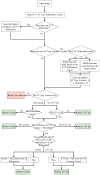Detecting Endotracheal Tube and Carina on Portable Supine Chest Radiographs Using One-Stage Detector with a Coarse-to-Fine Attention
- PMID: 36010263
- PMCID: PMC9406505
- DOI: 10.3390/diagnostics12081913
Detecting Endotracheal Tube and Carina on Portable Supine Chest Radiographs Using One-Stage Detector with a Coarse-to-Fine Attention
Abstract
In intensive care units (ICUs), after endotracheal intubation, the position of the endotracheal tube (ETT) should be checked to avoid complications. The malposition can be detected by the distance between the ETT tip and the Carina (ETT-Carina distance). However, it struggles with a limited performance for two major problems, i.e., occlusion by external machine, and the posture and machine of taking chest radiographs. While previous studies addressed these problems, they always suffered from the requirements of manual intervention. Therefore, the purpose of this paper is to locate the ETT tip and the Carina more accurately for detecting the malposition without manual intervention. The proposed architecture is composed of FCOS: Fully Convolutional One-Stage Object Detection, an attention mechanism named Coarse-to-Fine Attention (CTFA), and a segmentation branch. Moreover, a post-process algorithm is adopted to select the final location of the ETT tip and the Carina. Three metrics were used to evaluate the performance of the proposed method. With the dataset provided by National Cheng Kung University Hospital, the accuracy of the malposition detected by the proposed method achieves 88.82% and the ETT-Carina distance errors are less than 5.333±6.240 mm.
Keywords: coarse-to-fine attention; deep learning; endotracheal intubation; object detection.
Conflict of interest statement
The authors declare no conflict of interest. The funders had no role in the design of the study; in the collection, analyses, or interpretation of data; in the writing of the manuscript, or in the decision to publish the results.
Figures








Similar articles
-
Validation of a Deep Learning-based Automatic Detection Algorithm for Measurement of Endotracheal Tube-to-Carina Distance on Chest Radiographs.Anesthesiology. 2022 Dec 1;137(6):704-715. doi: 10.1097/ALN.0000000000004378. Anesthesiology. 2022. PMID: 36129686
-
Image augmentation and automated measurement of endotracheal-tube-to-carina distance on chest radiographs in intensive care unit using a deep learning model with external validation.Crit Care. 2023 Jan 25;27(1):40. doi: 10.1186/s13054-023-04320-0. Crit Care. 2023. PMID: 36698191 Free PMC article.
-
Identification and Localization of Endotracheal Tube on Chest Radiographs Using a Cascaded Convolutional Neural Network Approach.J Digit Imaging. 2021 Aug;34(4):898-904. doi: 10.1007/s10278-021-00463-0. Epub 2021 May 23. J Digit Imaging. 2021. PMID: 34027589 Free PMC article.
-
Role of ultrasound in confirmation of endotracheal tube in neonates: a review.J Matern Fetal Neonatal Med. 2019 Apr;32(8):1359-1367. doi: 10.1080/14767058.2017.1403581. Epub 2017 Nov 22. J Matern Fetal Neonatal Med. 2019. PMID: 29117819 Review.
-
Confirmation of endotracheal tube position: a narrative review.J Intensive Care Med. 2009 Sep-Oct;24(5):283-92. doi: 10.1177/0885066609340501. Epub 2009 Aug 3. J Intensive Care Med. 2009. PMID: 19654121 Review.
Cited by
-
Using the Regression Slope of Training Loss to Optimize Chest X-ray Generation in Deep Convolutional Generative Adversarial Networks.Cureus. 2025 Jan 13;17(1):e77391. doi: 10.7759/cureus.77391. eCollection 2025 Jan. Cureus. 2025. PMID: 39811723 Free PMC article.
-
A robust approach for endotracheal tube localization in chest radiographs.Front Artif Intell. 2023 May 12;6:1181812. doi: 10.3389/frai.2023.1181812. eCollection 2023. Front Artif Intell. 2023. PMID: 37251274 Free PMC article.
References
Grants and funding
- MOST 109-2634-F-006-023/Ministry of Science and Technology, Executive Yuan, Taiwan
- NCKUH-10901003/National Cheng Kung University Hospital, Tainan, Taiwan
- No Grant Number/Higher Education Sprout Project, Ministry of Education to the Headquarters of University Advancement at National Cheng Kung University (NCKU)
LinkOut - more resources
Full Text Sources

